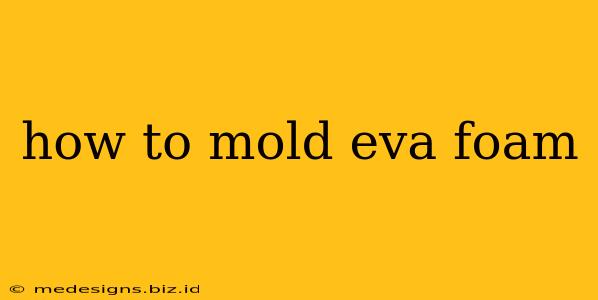EVA foam, known for its flexibility, durability, and ease of use, is a popular material for crafting a wide range of projects. From cosplay props to custom protective padding, learning how to mold EVA foam opens up a world of creative possibilities. This guide will walk you through the process, covering various techniques and considerations for achieving professional-looking results.
Understanding EVA Foam and its Properties
Before diving into molding techniques, it's crucial to understand EVA foam's characteristics. Its flexibility allows for intricate shapes, while its resilience ensures the mold holds its form. However, EVA foam can be tricky to work with if you don't understand its properties. Key considerations include:
- Thickness: Thicker foam requires more heat and pressure for molding.
- Type: Different EVA foam types have varying densities and melting points. Experiment to find what works best for your project.
- Temperature Sensitivity: EVA foam softens and becomes malleable with heat. Overheating can lead to burning or discoloration.
Molding Techniques: A Step-by-Step Approach
Several techniques can be employed to mold EVA foam, each offering unique advantages depending on the project's complexity and desired outcome.
1. Heat Gun Molding: Perfect for Simple Shapes
This method is ideal for smaller projects or creating basic shapes.
Materials:
- EVA foam sheets
- Heat gun
- Mold (wood, metal, or even a sturdy cardboard template)
- Heat-resistant gloves
- Safety glasses
Steps:
- Prepare your mold: Ensure your mold is clean and stable.
- Cut your foam: Cut the EVA foam slightly larger than your mold to account for shrinkage.
- Apply heat: Using the heat gun, gently and evenly heat the foam, moving the gun constantly to avoid burning. The foam should become pliable, almost like soft clay.
- Press into mold: Carefully press the heated foam into the mold, ensuring complete contact.
- Cool and set: Allow the foam to cool completely before removing it from the mold.
2. Vacuum Forming: For Complex Shapes and Larger Projects
Vacuum forming offers more precision and is suitable for intricate designs and larger pieces.
Materials:
- EVA foam sheets
- Vacuum forming machine (you can purchase or build one)
- Mold (typically made from wood or plaster)
- Vacuum pump
Steps:
- Prepare your mold: Ensure your mold is smooth and free from imperfections.
- Heat the foam: Use the vacuum forming machine to heat the EVA foam sheet to its softening point.
- Vacuum and form: Use the vacuum to pull the softened foam sheet down onto the mold, creating a precise replica.
- Cool and trim: Allow the foam to cool completely before carefully removing it from the mold and trimming any excess.
3. Contact Heat Pressing: A Precise Method for intricate details
This technique is excellent for achieving sharp details and consistent thickness.
Materials:
- EVA foam sheets
- Contact heat press (you can adapt a clothes iron for smaller pieces)
- Mold
- Heat-resistant materials
Steps:
- Prepare mold: Ensure mold is clean and level.
- Preheat press: Preheat the contact heat press to the manufacturer’s recommendation for EVA foam.
- Position foam and mold: Position EVA foam on top of mold.
- Press and cool: Press foam and mold between the heated plates of contact heat press for the recommended time. Let it cool completely before removing.
Tips for Success
- Practice makes perfect: Start with simple shapes to get a feel for the material and the molding process.
- Ventilation: Always work in a well-ventilated area when using a heat gun.
- Safety first: Wear heat-resistant gloves and safety glasses to protect yourself from burns and debris.
- Experiment with different techniques: Different techniques yield unique results, so experiment to find what works best for your project.
Expanding Your EVA Foam Molding Skills
Once you've mastered the basics, explore more advanced techniques like adding layers for thicker pieces, using different colors, and incorporating additional materials for added texture and details. The possibilities are truly limitless. With patience and practice, you'll be creating impressive EVA foam projects in no time!
